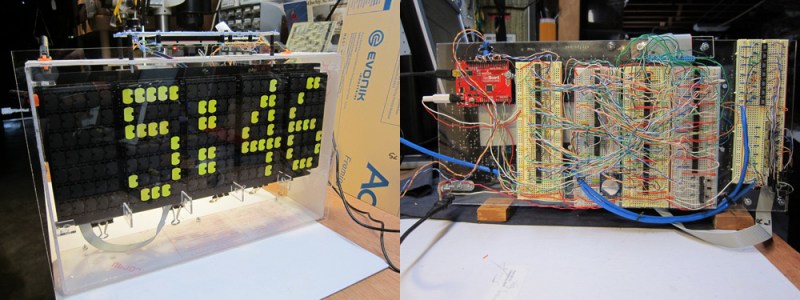What is it that we like so much about inefficient, noisy clocks made with inappropriate technology? Answer the question for yourself by watching the video (below) that [David Henshaw] sent us of Dottie, the flip-dot clock.
But besides the piece itself, we really like the progression in the build log, from “how am I going to do this?” to a boxed-up, finished project.
Another stunning aspect of this build is just how nice an acrylic case and a raft of cleverly written software can make a project look. You’d never guess from the front that the back-side was an (incredible) rat’s nest of breadboards and Ethernet wires. Those random switching patterns make you forget all the wiring.
And the servo-steered, solenoid-driven chimes are simply sweet. We’re sure that we’d love to hear them in real life.
We tracked down the referenced electronics.stackexchange post with the circuit diagram, and we’re guessing that the diodes actually allow a simplification of the driver circuit. Perhaps our readers will be up for the challenge. Not that we’d be in any hurry to even touch those breadboards…
















The few times I saw these flip dot displays on ebay, they were prohibitively expensive (>$400), especially considering they were salvaged from old buses.
Hi, I’m David who built the Flip Dot Clock. If you’re interested in the code on how to do this, I’ve posted it at http://www.dhenshaw.com/dottie (check the bottom of the page). @florinc, I got each sign for about $30… see http://www.rollsigngallery.com/
Theres something funny about using an LCD to control a dot-matrix.
I hope dot displays/flip-letter displays become more economical, they’re so fun. Are they expensive because they’re out of production, or are they hard to make?
I wonder whether they are hard to make from scrap, now that you can get neodymium magnets cheaply in quantity. (Well, coil winding may be quite work-intensive, but then it adds to the coolness factor :D)
“I wonder whether they are hard to make […]”
http://www.flipdots.com/how-it-works.html
http://www.google.com/patents/US3303494
HTH.
“[…] because they’re out of production […]”
Looks like (at least) flipdots.com still creating them. Haven’t looked any further yet…
If you have a Total Plastics warehouse near you they may have scrap acrylic cheaper than TAP.
If you’re using breadboards your project isn’t finished. it’s not hard or expensive to get some PCBs made
A post on Monday* said flip-dot displays are some of the most efficient. This post says they’re inefficient. Which is it?
* http://hackaday.com/2014/10/20/controlling-a-flip-disc-display-using-android/
Dottie the flip dot clock draws 0.4 amps at 9 volts when any flipping is happening (and 0 when nothing is flipping) + 0.3 amps to power the Arduino and LCD continuously
Efficient like ePaper; only consuming power when changing. Though mechanical displays likely take a bit more power to actuate (coils)
This is gorgeous. I’ve been wanting to build a flip-dot-something for ages, but the cost of the modules put me off. A clock is a perfect use-case for this, since it only requires a few modules.
I hope nobody would be upset if I started working on a kit flipdot clock. :)
Regarding the question about the diodes, they are present to ensure there’s only one current path when a row and column are turned on – similar to the classic ‘keyboard ghosting’ problem. Without diodes, if you enable row A and column 1, there’s also a path through solenoids A2 -> B2 -> B1 (and every other rectangle with one corner at A1).